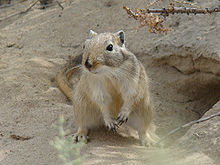The great gerbil (Rhombomys opimus) is a large rodent found throughout much of Central Asia.
| Great gerbil Temporal range: | |
|---|---|
 | |
| Scientific classification | |
| Domain: | Eukaryota |
| Kingdom: | Animalia |
| Phylum: | Chordata |
| Class: | Mammalia |
| Order: | Rodentia |
| Family: | Muridae |
| Genus: | Rhombomys Wagner, 1841 |
| Species: | R. opimus |
| Binomial name | |
| Rhombomys opimus (Lichtenstein, 1823) | |
Description
The largest of the gerbils, great gerbils have a head and body length of 15–20 cm (6–8 in). Their skulls are distinctive by having two grooves in each incisor. They have large front claws used for burrowing.[2]
Distribution and habitat
Great gerbils are found in arid habitats, predominantly in sandy or clay deserts. They are found in Turkmenistan, Kazakhstan, Mongolia, China, Pakistan, Afghanistan, and Iran.[1]
Predators
The great gerbil is preyed on by foxes, owls, kites, wildcats, weasels, vultures, and cobras.
Ecology and behavior
Great gerbils live in family groups and occupy one burrow per family.[3] Their burrows can be fairly extensive with separate chambers for nests and food storage. Great gerbils spend considerably more time in the burrows during winter, but do not hibernate. They are predominantly diurnal. Food consists mostly of vegetable matter.[2]
The animals are often colonial. Longevity is 2–4 years. Burrow system complexes have a distinctive region of cleared soil and can be seen and mapped from aerial photos and satellite images.[4] Inhabited great gerbil burrows can be distinguished from abandoned burrows using satellite images.[5]
Great gerbils are known reservoirs of Yersinia pestis, the bacterium that causes plague, and of Leishmania major, the causative agent of zoonotic cutaneous leishmaniasis. They are also known as crop pests and have been implicated in exacerbating erosion.
References
- Nowak, R. M. (1999). Walker's Mammals of the World. Vol. 2. London: Johns Hopkins University Press.
External links
 Media related to Rhombomys opimus at Wikimedia Commons
Media related to Rhombomys opimus at Wikimedia Commons

